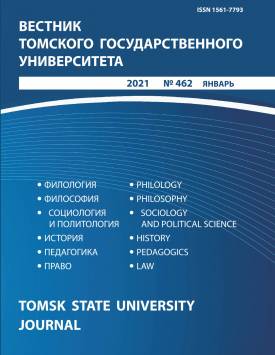The British Youth Service in 1990-2010
The present article examines the modernization of the Youth Service - a specific instrument in the implementation of state policy in the sphere of youth socialization in the UK. The author aimed to reveal the causes of modernization, which was achieved after the analysis of statutory documents of British authorities concerning young people and children; information taken from the British government's official website about cooperation with voluntary organizations; works of foreign and national authors: experts in the implementation of state policy in the sphere of youth socialization - Anthony Giddens and Tom Wiley; researchers of the evolution of youth policy in foreign countries in the second half of the 20th century - A.A. Popov and V.S. Efimov, and researchers of the history of the British Youth Service creation - S.V. Fomenko and Graham Brotherton. Despite the existing opinion about the ultimate formation of a “democratic approach” to the evaluation of the place and role of young people in society by the middle of the 1990s, the author tends to consider the middle of the 1990s not as the end, but as the beginning of the rethinking of the British government's position towards young people. As a result, the efforts of state and non-state social services began to focus on assistance not only to youth from the “risk group”, but also to such categories of young people which are oriented to active work, study, professional growth. Hence, the specific instrument of state policy implementation in the sphere of British youth socialization - the Youth Service - had also exercised radical modernization in 1990-2010. Among the reasons for the modernization, the author reckons the following: (1) the shift of youth policy emphasis from teenagers and young people towards infancy according to the loss of personal life benchmarks together with the lack of the “ontological security” feeling; (2) the extension in the domain of government's actions on youth problems in a “horizontal” direction. In the author's opinion, the first reason contributed to the legislative recognition of such a phenomenon as Children's and Youth Trusts, which at the beginning of the 2000s opened a perspective for the development of an intersectoral approach in the solution of youth problems at the local level and led the trusts to become the major structure, at the local level, that operates a contact between various agencies influencing the youth socialization process. The second reason removed the sole responsibility of the Department of Education for the implementation of state youth policy allocating it between other departments.
Keywords
Youth Service, modernization, Children's and Youth Trust, intersectoral approach, partnershipAuthors
| Name | Organization | |
| Kataman Dmitriy O. | Omsk State University | katamandmitry@gmail.com |
References

The British Youth Service in 1990-2010 | Vestnik Tomskogo gosudarstvennogo universiteta – Tomsk State University Journal. 2021. № 462. DOI: 10.17223/15617793/462/15
